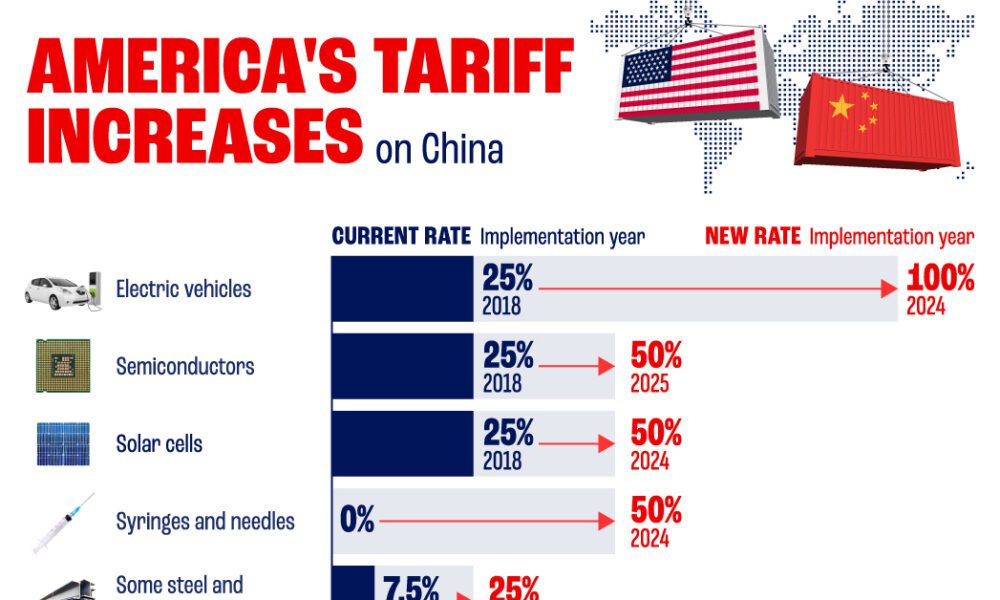The Asia Summit: Balancing US Tariffs And The Rise Of China

Table of Contents
The Impact of US Tariffs on Asian Economies
The imposition of US tariffs has significantly disrupted Asian economies, creating a ripple effect felt across various sectors.
Disruption to Supply Chains
US tariffs have severely impacted global supply chains, with Asian nations bearing the brunt of the disruption. These "trade wars" have forced businesses to re-evaluate their manufacturing and distribution strategies, leading to increased costs and uncertainty.
- Electronics: The tariffs on electronics components have increased production costs for many Asian manufacturers, impacting their competitiveness in the global market.
- Textiles: The textile industry, heavily reliant on trade between Asian countries and the US, has seen significant job losses and reduced exports.
- Vietnam: While some countries have benefited from diverted investment, Vietnam, a significant manufacturing hub, has faced challenges adapting to shifting supply chains and increased demand.
The resulting supply chain disruptions have created significant uncertainty and instability for businesses operating within Asian economies.
Regional Economic Instability
The economic instability resulting from US tariffs is far-reaching. The impact extends beyond specific industries, affecting overall economic growth and stability across the region.
- GDP Impact: Many Asian economies have experienced a slowdown in GDP growth due to reduced exports and decreased foreign investment.
- Inflation: Increased tariffs have led to higher prices for consumers, contributing to inflation in several Asian countries.
- Foreign Investment: The uncertainty surrounding trade policies has discouraged foreign direct investment (FDI), hampering economic development.
Understanding the full tariff impact on Asian economic growth requires a nuanced analysis, considering both direct and indirect effects.
China's Expanding Influence in Asia
China's economic and political influence continues to expand rapidly across Asia, presenting both opportunities and challenges for the region.
The Belt and Road Initiative (BRI)
The Belt and Road Initiative (BRI) is a key driver of China's growing influence. This ambitious infrastructure project involves massive investments in transportation, energy, and communication networks across Asia and beyond.
- Project Examples: The China-Pakistan Economic Corridor (CPEC) and various rail and port projects across Southeast Asia exemplify the scale of BRI investments.
- Economic Benefits: BRI projects offer participating nations access to new markets, improved infrastructure, and increased economic activity.
- Geopolitical Risks: However, concerns remain regarding debt sustainability, environmental impact, and the potential for geopolitical influence by China.
The BRI's long-term effects on regional power dynamics are still unfolding.
Technological Advancement and Competition
China's rapid technological advancements are reshaping Asian tech markets, sparking competition with US tech giants.
- 5G Technology: China's advancements in 5G technology pose a significant challenge to US companies vying for dominance in this crucial sector.
- Artificial Intelligence (AI): China is making significant strides in AI development, competing with the US in both research and application.
- Competition with US Tech Companies: The competition between Chinese and American tech companies is intensifying, influencing the technological landscape of the Asian region.
This technological competition is shaping the future of innovation and economic growth in Asia.
Balancing Act for Asian Nations
Asian nations face the complex challenge of navigating the evolving relationship between the US and China while maintaining economic stability and security.
Navigating US-China Relations
Maintaining balanced relationships with both superpowers requires careful diplomatic maneuvering.
- Neutrality: Some nations attempt to maintain a neutral stance, seeking to benefit from both economies without alienating either.
- Alignment Risks: Aligning too closely with either side carries significant risks, potentially leading to economic sanctions or political pressure.
This delicate balancing act is crucial for the future of the region’s geopolitics.
Strategies for Economic Diversification
To mitigate risks associated with dependence on either the US or China, many Asian nations are pursuing economic diversification strategies.
- Trade Diversification: Expanding trade relationships with other countries reduces vulnerability to disruptions in US-China trade.
- Investment Diversification: Attracting investment from diverse sources strengthens economic resilience.
- Regional Cooperation: Strengthening regional economic partnerships can foster greater stability and shared prosperity.
These proactive strategies are vital for mitigating risks and enhancing long-term economic sustainability.
Conclusion: The Future of the Asia Summit: Managing Tariffs and China's Rise
The Asia Summit provides a crucial platform for addressing the complex interplay between US tariffs, China's growing influence, and the challenges faced by Asian nations. This article has highlighted the significant disruptions caused by US tariffs on Asian supply chains and economies, alongside China's increasing economic and technological power. Asian nations must navigate this delicate balance, pursuing strategies for economic diversification and careful diplomacy to ensure long-term stability and prosperity. Stay updated on the future of the Asia Summit and its implications for the region; further research into the impact of US tariffs on Asian economies is vital for informed policymaking and future economic planning. Understanding the rise of China in Asia is crucial for future economic and political stability.

Featured Posts
-
 How To Watch 1923 Season 2 Episode 5 Tonight For Free
May 27, 2025
How To Watch 1923 Season 2 Episode 5 Tonight For Free
May 27, 2025 -
 Atlantas High Surveillance Camera Density Implications And Concerns
May 27, 2025
Atlantas High Surveillance Camera Density Implications And Concerns
May 27, 2025 -
 Sarah Fergusons Ppe Offer During Pandemic Inquiry Reveals Details
May 27, 2025
Sarah Fergusons Ppe Offer During Pandemic Inquiry Reveals Details
May 27, 2025 -
 Yueksek Belirsizlik Ecb Baskani Lagarde Nin Son Degerlendirmesi
May 27, 2025
Yueksek Belirsizlik Ecb Baskani Lagarde Nin Son Degerlendirmesi
May 27, 2025 -
 Alien Contact The Fate Of Earth Hangs In The Balance
May 27, 2025
Alien Contact The Fate Of Earth Hangs In The Balance
May 27, 2025
Latest Posts
-
 Stjerne Kritiserer Dansk Chef Mangel Pa Respekt
May 30, 2025
Stjerne Kritiserer Dansk Chef Mangel Pa Respekt
May 30, 2025 -
 Chokskifte Og Mal Dolbergs Ambition Om 25 Mal
May 30, 2025
Chokskifte Og Mal Dolbergs Ambition Om 25 Mal
May 30, 2025 -
 Intet Er Besluttet Endnu Seneste Nyt Og Rygter Fra Tipsbladet Dk
May 30, 2025
Intet Er Besluttet Endnu Seneste Nyt Og Rygter Fra Tipsbladet Dk
May 30, 2025 -
 Dolberg 25 Mal En Realistisk Malsaetning Chokskifte I Sigte
May 30, 2025
Dolberg 25 Mal En Realistisk Malsaetning Chokskifte I Sigte
May 30, 2025 -
 Intet Er Besluttet Endnu Hvad Betyder Det For Fremtiden
May 30, 2025
Intet Er Besluttet Endnu Hvad Betyder Det For Fremtiden
May 30, 2025
